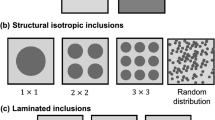Abstract
Bonded-particle model (BPM) is widely used to model the cracking processes in rock/rock-like materials. However, the discrete particles in the BPM cannot produce a continuous displacement field, which is comparable with those in physical experiments and numerical method such as the finite element method. Displacement trend lines are introduced to analyze the displacement field type of the BPM in the present study. Three displacement field types (DF_I, DF_II and DF_III) are defined and used in the analysis of the cracking processes. The study shows that the type of displacement field may evolve during the cracking processes. Researchers are advised to examine the displacement field before and right after a particular crack has formed. An examination of the associated type of displacement field can help reveal the nature of the crack.







Similar content being viewed by others
References
Bahaaddini M, Sharrock G, Hebblewhite BK (2011) A comparison of physical and numerical experiments on artificial jointed rock masses using PFC3D. In: 2nd International FLAC/DEM Symposium, 1st edn. Itasca Consulting Group, Melbourne
Bobet A, Einstein HH (1998) Fracture coalescence in rock-type materials under uniaxial and biaxial compression. Int J Rock Mech Min Sci 35:863–888
Bock H, Blumling P, Konietzky H (2006) Study of the micro-mechanical behaviour of the Opalinus Clay: an example of co-operation across the ground engineering disciplines. Bull Eng Geol Environ 65:195–207
Cho N, Martin CD, Sego DC (2007) A clumped particle model for rock. Int J Rock Mech Min Sci 44(7):997–1010
Cho N, Martin CD, Sego DC, Jeon J (2010) Dilation and spalling in axially compressed beams subjected to bending. Rock Mech Rock Eng 43(2):123–133
Ding XB, Zhang LY (2012) Effect of model scale on mechanical properties of rocks based on PFC3D modeling. In: 46th US Rock Mechanics/Geomechanics Symposium, Chicago, IL, USA
Einstein HH, Dershowitz WS (1990) Tensile and shear fracturing predominantly compressive stress-fields- a review. Eng Geol 29:149–172
Ghazvinian A, Sarfarazi V, Schubert W, Blumel M (2012) A Study of the failure mechanism of planar non-persistent open joints using PFC2D. Rock Mech Rock Eng 45:677–693
Itasca (2004) PFC2D (Particle Flow Code in 2 Dimensions) Version 3.1, Minneapolis
Itasca (2007) PFC3D—Particle Flow Code in 3 Dimensions, Ver. 4.0 Pre-release, Minneapolis
Mas Ivars D, Pierce M, DeGagné D, Darcel C (2008) Anisotropy and scale dependency in jointed rock-mass strength—a synthetic rock mass study. In: 1st International FLAC/DEM Symposium. Itasca Consulting Group, Minneapolis
Min KB, Niemeijer A, Elsworth D, Marone C (2007) Distinct element modeling of coupled chemo-mechanical compaction of rock salt, Euroconference of rock physics and geomechanics on natural hazards: thermo-hydro-mechanical processes in rocks. Erice, Italy, pp 45–46
Park N (2006) Discrete element modeling of rock fracture behavior: fracture toughness and time-dependent fracture growth. Ph.D. Thesis. The University of Texas at Austin
Potyondy DO (2007) Simulating stress corrosion with a bonded-particle model for rock. Int J Rock Mech Min Sci 44(5):677–691
Potyondy DO (2010) A grain-based model for rock: approaching the true microstructure, in Proceedings Proceedings of Rock Mechanics in the Nordic Countries. Kongsberg, Norway
Potyondy DO (2012) A flat-Jointed bonded-particle material for hard rock, 46th US Rock Mechanics/Geomechanics Symposium held in Chicago. IL, USA, pp 24–27
Potyondy DO, Cundall PA (2004) A bonded-particle model for rock. Int J Rock Mech Min Sci 41(8):1329–1364
Shimizu H, Koyama T, Ishida T, Chijimatsu M, Fujita T, Nakama S (2010) Distinct element analysis for Class II behavior of rocks under uniaxial compression. Int J Rock Mech Min Sci 47(2):323–333
Thompson N, Mas Ivars D, Alassi HT, Pradhan S (2011) Investigation of the Synthetic Rock Mass approach for the consideration of reservoir behavior. In: 2nd International FLAC/DEM Symposium, 1st edn. Itasca Consulting Group, Melbourne
Wong LNY, Einstein HH (2009) Crack coalescence in molded gypsum and Carrara Marble: part 2-microscopic observations and interpretation. Rock Mech Rock Eng 42(3):513–545
Wu JY, Zhu YS, Zhu HC (2011) A continuum representation and validation of time-dependent crack growth behavior of brittle rock. In: 2nd International FLAC/DEM Symposium, 1st edn. Itasca Consulting Group, Melbourne
Zhang X-P, Wong LNY (2013) Crack initiation, propagation and coalescence in rock-like material containing two flaws: a numerical study based on bonded-particle model approach. Rock Mech Rock Eng 46(5):1001–1021
Zhang X-P, Wong LNY (2012) Cracking processes in rock-like material containing a single flaw under uniaxial compression: a numerical study based on parallel bonded-particle model approach. Rock Mech Rock Eng 45:711–737
Zhang Q, Zhu HH, Zhang LY, Ding XB (2012) Effect of micro-parameters on the Hoek-Brown strength parameter mi for intact rock using particle flow modeling, 46th US Rock Mechanics/Geomechanics Symposium, Chicago, IL, USA
Acknowledgments
The research was supported by the Academic Research Fund Tier 1 (RG19/10) and the Nanyang Technological University Start Up Grant (M4080115.030). The first author was also supported by the Open Research Fund of Key Laboratory of Engineering Geomechanics, Institute of Geology and Geophysics, Chinese Academy of Sciences, under grant NO. KLEG201102. The authors thank Professor Faquan Wu for his valuable comments and suggestions during the paper review process.
Author information
Authors and Affiliations
Corresponding author
Rights and permissions
About this article
Cite this article
Zhang, XP., Wong, L.N.Y. Displacement field analysis for cracking processes in bonded-particle model. Bull Eng Geol Environ 73, 13–21 (2014). https://doi.org/10.1007/s10064-013-0496-1
Received:
Accepted:
Published:
Issue Date:
DOI: https://doi.org/10.1007/s10064-013-0496-1




